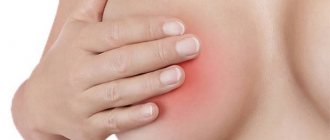Breast health » Beauty and health
- Vitiligo
- Cosmetic treatment method
Are light nipples in women a disorder or normal? In most cases, the white tint of the nipples is an individual feature of the mammary glands. However, medicine knows situations in which a whitish tint of the nipple skin is a characteristic sign of pathology.
Let's look at the reasons why nipples turn white, how dangerous this condition is and whether it is necessary to get rid of it.
Features of changing the shade of the nipples
Why do some women have white nipples? The reasons for the uncharacteristic color of the nipples can be either pathological or natural in origin. Therefore, doctors note:
- If the light shade of the papillae is noted from birth and does not bother the woman physically in any way, then most likely this is a specific feature of her bust.
- The situation is completely opposite, when the nipples used to have a normal color, but for some reason they became much lighter, and are accompanied by unusual symptoms, indicating the presence of some kind of disease.
| Norm | Anomaly |
| Individual feature. Age-related changes. Pregnancy period. Lactation. | Vitiligo. Albinism. Fordyce granules. Blocked milk ducts. Breast thrush. Raynaud's phenomenon. Incorrect attachment of the baby to the breast. Neoplasms in the breast. |
Let's analyze the features of conditions and disease processes in which the mammary papillae can acquire a whitish tint and why this happens.
Depigmentation
The problem of the appearance of white spots around the nipples as a symptom of vitiligo requires separate consideration.
Vitiligo is a disease of autoimmune origin. In such cases, the causes of the disease are unclear. The following actions will help reduce the consequences of the body’s struggle with its own cells:
- Avoiding stress
- Normalization of the gastrointestinal tract and liver
- Regular massage and other relaxing treatments
- Increasing immunity by taking vitamin complexes and immunomodulators
Natural Causes of White Nipples
Mammologists identify a number of situations in which pale nipples are classified as non-pathological situations.
Individual feature
As you know, the substance melanin (a natural pigment) is responsible for the color of skin, hair and eyes in women and men. Depending on the degree of concentration of this substance in the body, all people are divided into blondes and brunettes.
A blond person has much less melanin, which is why he has blond hair and skin that practically does not tan in the sun. Blondes have very light nipples. In women of this type, the papillae have a pink color of varying intensity, so they often look slightly whitish.
Brunettes have much darker hair and skin, and after tanning it takes on a distinct brownish tint. Accordingly, the areola-nipple area in such women is more saturated brown.
Age-related changes
Often, the areas of the areola and nipples become lighter due to age-related changes in the body due to genetic predisposition or natural aging of the body.
With the advent of menopause, the production of progesterone and estrogen decreases, which does not have the best effect on the skin of the breast. The mammary glands lose their elasticity. Due to the lack of natural fat secretions, the skin becomes drier and wrinkled, and begins to flake. It is the flakes of dead skin particles that give the nipples a whitish tint.
If the change in nipple color is not accompanied by any unpleasant signs, there is no need to worry. In older women, this condition is considered within normal limits.
Pregnancy
During pregnancy, the areolas and nipples often acquire a more expressive color, but it also happens that only the areolar zone darkens, so the papilla appears lighter against its background.
On the other hand, with the onset of the third trimester of pregnancy, the process of producing colostrum begins in the mammary glands. At the beginning of its appearance, colostrum fluid has a transparent consistency, but closer to childbirth it becomes white. Randomly released droplets of colostrum can dry out on the nipples, which affects their color.
Pathological causes of pale nipples
And yet there are times when nipples can turn white for pathological reasons. Provoking factors for nipple depigmentation are divided into two types:
- Congenital.
- Purchased.
Vitiligo
This disease is characterized by the absence of melanin in certain areas of the body, including the papillae. Vitiligo usually does not cause physical discomfort and is more often considered a cosmetic defect than a disease.
Vitiligo is characterized by periodic manifestations, that is, it can disappear and then reappear, while the appearing light spots increase in size, combining into one large spot.
Vitiligo can be congenital or acquired. The acquired form develops against the background of:
- Negative effects of certain drugs and chemicals.
- Endocrine diseases.
- Autoimmune diseases.
- Neurotrophic abnormalities.
- Stressful situations.
- Protracted ailments of internal organs.
- Regular friction against synthetic fabrics.
Albinism
Pathology refers to hereditary diseases and is caused by a genetic feature of the human body, in which there is a complete absence of the melanin pigment. However, medicine also knows a partial form of this disease.
Albino people have eyes, hair and skin of the body, including the mammary glands, with an expressive snow-white hue.
Fordyce granules
The formation of Fordyce papules is a consequence of improper placement of the sebaceous glands. A characteristic feature of granules is that they look like whitish pimples on the breast nipples. They usually appear in girls during puberty.
The disease has two types of manifestation:
- Genetic.
- Acquired.
With a congenital nature, the baby is born with displaced sebaceous glands. Their active development occurs in adolescence, from approximately 13 to 17 years. During their development, they produce a specific secretion. As a result, white spots appear on the areola, and the nipples become white.
The disease is not dangerous and does not spread through contact.
However, medicine also knows an acquired type of Fordyce granules - Fox-Fordyce syndrome. Pathology manifests itself against the background of hormonal imbalance. In this situation, the nipples first look whitish, and then become a deep burgundy color and begin to itch.
Blockage of milk ducts
If a nursing mother's nipples turn white, this may be a symptom of blocked milk ducts.
In this case, the papilla becomes white due to the fact that the milk cannot come out. As a result, white spots or a whitish coating appear on it.
When sucking, the baby does not receive milk and begins to suckle more intensely, thereby injuring the delicate skin, which leads to its redness. As milk accumulates, the breasts become inflamed, the temperature rises, and other painful symptoms appear.
Thrush
The causative agent of the disease is Candida fungus, which can be found in the oral cavity of infants. In this case, the mother becomes infected from the child while feeding him.
The main symptom of candidiasis is curdled discharge from the mammary gland with a sour odor, accompanied by itching and redness. As the disease worsens, milky-white formations or a film appear on the papillae and areolas, which visually gives the nipples a whitish color.
If you suspect thrush, you should consult a doctor, and treatment is required for both the mother and the newborn. The patient is prescribed medications and alternative treatment options.
Raynaud's phenomenon
Raynaud's disease or vasospasm manifests itself independently, regardless of the presence of lactation. Develops against the background:
- Stress.
- Colds.
- Damage to the nipple.
A narrowing of small blood vessels occurs, the so-called vasospasm, thereby blocking the flow of blood to certain parts of the body, as indicated by the manifestation of severe pain and the temporary disappearance of the melanin pigment.
The disease is most often diagnosed in women aged 20-49 years. It is usually noted on the fingers of the upper and lower extremities, but can sometimes appear on the nipples.
In nursing women, vasospasm occurs if the baby’s gums come into contact with the nipple or a sharp change in local temperature occurs, which is observed when the nipple is pulled out of the baby’s mouth. This type of spasm occurs simultaneously on both papillae: first they turn white, then turn red or blue, and only then return to their natural color.
The process is accompanied by severe discomfort, but for some women it can be painless.
Incorrect attachment of the baby to the breast
Systematically incorrect latching of a baby's nipple at the time of feeding negatively affects not only its condition, because the baby does not receive enough nutrition, but also the woman's mammary glands.
If the baby's position is incorrect when feeding, the nipple may become white and flat. In this situation, the young mother needs to master the technique of correctly attaching the baby to the mammary gland.
Neoplasms
If one nipple is dark and the other is much lighter, then most likely this is a sign of pathological changes in the structure of the mammary glands - malignant or benign.
In this situation, it is necessary to visit a doctor and conduct a thorough examination of the body to exclude the presence of a malignant tumor. For this purpose, various hardware tests are prescribed, among which the main ones are ultrasound and mammography.
If the diagnostic results do not show the presence of pathology, most likely the light shade of one nipple compared to the other is caused by the individual condition of the female body, or age-related changes.
Sources of pathology
If white dots appear on the nipple, the causes may be genetic, autoimmune, or hormonal diseases. One of the rare sources of rash is acrofacial vitiligo, which is diagnosed in 1-2% of cases. This hereditary disease develops at the hereditary level and is characterized by the appearance of spots not only on the nipples, but also on the face and fingertips.
A stressful situation, vitamin deficiency, digestive system disorders, endocrine diseases, prolonged and frequent exposure to ultraviolet rays can become a trigger factor for the development of acrofacial vitiligo.
Another rare cause of white spots on the nipples is partial albinism. The pathology also has a hereditary etiology. The first symptoms, that is, spots, appear after birth or in early childhood. In this case, other clinical manifestations do not occur, and specific therapy is not required.
White dots often appear on the nipple of the breast during puberty and menopause. At this time, changes occur at the hormonal level, in particular, the levels of the hormones estrogen, testosterone and progesterone change.
After their natural volume is restored and the surges disappear, melanin production returns to normal and the spots disappear.
Common causes of pathology
A common cause of white spots on the nipples is blockage of the sebaceous ducts.
This may be caused by:
- increased sweat production, for example, during intense physical activity;
- wearing synthetic or too tight underwear;
- lack of personal hygiene.
Pimples caused by clogged pores are similar in photo symptoms to teenage acne. They are white, and sometimes red, the contents are gray-greenish exudate, which comes out when squeezed out.
Another common cause is Fordyce granules or seborrheic cysts. The neoplasms are milky or yellowish-white in color and appear during puberty.
Due to the hormonal changes that occur, the composition of sebum changes, the density and density increases, which causes blockage of the sebaceous ducts.
During breastfeeding
If the white dot on the nipple hurts during breastfeeding, this indicates a blockage of the milk duct. A plug forms in the gland, which prevents the natural release of colostrum. In this case, milk stagnation occurs, an inflammatory process and nipple hyperemia develop.
If appropriate measures are not taken, against the background of a prolonged stagnation process, the breastfeeding woman develops swelling of the mammary gland, the general temperature rises, which disrupts the general condition and reduces performance.
Such symptoms when feeding a child should alert you and become a reason to consult a doctor, as the risk of developing mastitis or lactostasis increases.
Often during breastfeeding, white spots appear on the nipples, which are a sign of the development of thrush. The danger of the pathology is that it is easily transmitted from a sick mother to a child through salivary fluid. In addition to photo-symptoms in the form of a rash, peeling, itching, and sometimes pain are observed.
If clinical manifestations of thrush are detected, a woman who is breastfeeding should consult a doctor who will prescribe diagnostic measures and confirm or refute the diagnosis.
During pregnancy
During pregnancy, the appearance of white spots is caused by a condition called Montgomery's tubercles. The glands are activated against the background of hormonal changes, which makes them more noticeable. According to doctors, enlarged tubercles signal that the body is preparing for the lactation period.
It is not uncommon for the appearance of white dots to indicate early pregnancy; however, this is not a specific sign, nor is it a deviation from the norm. In the absence of other severe symptoms, this condition does not pose a threat to the woman’s health.
The inflammatory process in the glands occurs in early pregnancy, against the background of a decrease in the body's defenses and the penetration of infectious microorganisms into the milk ducts.
Among the characteristic symptoms are an increase in the size of the tubercles, hyperemia and pain. After consulting a doctor, antibacterial drugs are prescribed to eliminate inflammation and prevent complications.
Is this condition dangerous?
As you can see, nipples can turn white not only due to a woman having some kind of disease. The condition of the breast may be determined by the individual characteristics of the body.
Whether or not you need to see a doctor depends on the situation and the symptoms you are experiencing. If a woman is not worried about anything and feels consistently good, a visit to the doctor’s office can be postponed until a scheduled visit to a mammologist.
However, if unusual and painful symptoms occur and the woman is pregnant or breastfeeding, a specialist should be consulted.
You should especially seek help immediately if you experience:
- White film on nipples.
- White plaque in the baby's mouth.
- Breast tenderness.
- Manifestation of sharp pain radiating deep into the gland.
- The formation of poorly healing cracks in the nipples.
- Increased body temperature.
- The appearance of discharge from the nipple of an unnatural color.
- Pain occurs in only one breast.
- Only one nipple turned sharply white.
- Swelling of the mammary glands.
Blockage of the milk ducts during lactation requires immediate removal of the plug, due to which the milk cannot come out. Exacerbation of the situation is dangerous with inflammation of the mammary gland and other serious complications.
Is treatment required?
Do I need to take any therapeutic measures if my nipples have turned white? The specifics of the therapeutic intervention depend on what exactly provoked the abnormal phenomenon.
If the reason is the presence of some disease in the female body, then the doctor prescribes a treatment regimen that is practiced for this disease:
| State | Features of treatment |
| Thrush | Treatment of thrush is based on an integrated approach. Recommended medications for oral and external use: Miconazole ointment, Candide cream, Nizoral cream, Nystatin ointment, Fluconazole. |
| Additional remedies include: - green tea (suppresses the activity of Candida fungus); - washing the nipples and areolas with a soda solution (1 tsp soda per glass of boiled water); - compresses with vinegar. (add 1 tsp of apple cider vinegar to 100 ml of boiled water. Soak gauze in the solution and apply to the problem area); - exclusion of sweets and foods with yeast from the diet. | |
| Raynaud's syndrome | Therapeutic measures are prescribed (breast massage, air baths, rubbing the skin with oils, etc.). |
| Taking vitamin B6 complex with niacin. Treatment regimen: 100 mg twice daily for several weeks. | |
| Taking Nifedipine. The remedy is prescribed if the methods described above are ineffective. Dosage – 1 tablet per day. The duration of the treatment course is 2 weeks. | |
| Milk stagnation during breastfeeding | In this situation, it is recommended to put the baby to the breast as often as possible so that his chin rests on the area of the plug. Self-massage of the breast is also recommended. If a woman is unable to resolve the problem on her own, she should contact a lactation consultant or mammologist. |
| Vitiligo | Often medications are prescribed that affect the synthesis of melanin and improve metabolic processes in the body, vitamin therapy, and hormonal agents. A good effect is achieved with ultraviolet irradiation, as well as after completing a course of PUVA therapy. |
| Fordyce granules | There are no effective treatments. Basically, the disease disappears on its own by the age of 40. Itchy discomfort can be eliminated through laser correction. |
Additionally, a woman should follow all medical recommendations:
- After feeding, immediately cover your breasts with a warm, damp towel.
- After taking a shower, you should also cover your bust to prevent cold air from entering.
- If a burning sensation is felt, you need to create conditions for an additional flow of blood to the nipple. Olive oil helps a lot in this regard. Take some oily liquid, warm it between your fingers and massage your nipples. This massage significantly reduces pain.
- Dry applications. After feeding, lie down and apply warm heating pads to the areola-nipple area for a few minutes.
- Vitamin therapy.
- Intensive massage of the chest (the area between the collarbone and mammary glands), while the breast itself is not affected.
- Gentle massage of the muscles under the breasts and armpits.
Cosmetic treatment method
In the absence of pathological conditions, when the whitening of the nipples is caused by natural causes, their color can be improved with the help of tattooing.
Cosmetic nipple dyeing is the introduction of a colored pigment under the skin of the areola. The tattoo itself is performed in several stages, using different types of techniques using several pigment substances, thereby achieving their uniform distribution in the tissues of the areolar-nipple area.
Immediately before the procedure itself, the patient receives recommendations about possible contraindications and nipple care in the post-procedure period.
Nipple dyeing technique;
- Anesthesia is performed with a special cream (injections are not practiced in tattooing due to excessive sensitivity of the chest area).
- The introduction of hypoallergenic dyes is carried out with a special device with one or three needles.
- Next, the pigment is shaded or the contour version of the parchment is saved.
- The duration of the correction is approximately an hour.
- The area of the nipples and areola is smeared with cream and covered with cling film for 4-6 hours.
Further care is the same as with other types of tattooing: application of wound-healing agents, antibacterial procedures, avoidance of sunlight on the skin.
The cosmetic effect lasts for an average of 5 years, but experts recommend correction every 2-2.5 years.
White spots in early pregnancy
A short time after pregnancy, women notice the appearance of specific pimples and spots around the nipples. The glands located in these tubercles around the nipples respond to changes in hormonal levels and begin to produce a special oily substance, maintaining the softness and elasticity of the skin of the nipples.
Scientists believe that the substance produced by Montgomery's tubercles attracts breastfed babies. They help him find the nipple when the mother begins to feed the baby for the first time. In addition, the secretion of the glands serves as a lubricant and protects the surface of the nipple and the entrance to the milk ducts from germs.
Changes in the size and number of visible Montgomery tubercles on the nipple are considered one of the earliest indicators of pregnancy. Active secretion production makes the tubercle look like a small bump with a white or yellowish top.
Montgomery's tubercles may enlarge and turn white regardless of pregnancy. The reasons for their manifestation may be:
- Hormonal changes before and during menstruation
- Taking oral contraceptives
- Menopause
- Other changes in hormonal profile
The manifestations of Montgomery tubercles near the nipple are painless and do not require treatment when they occur. However, it is not recommended to pierce the surface or squeeze out the contents of the tubercle due to the risk of infection. Painful sensations in the nipples and redness of the Montgomery tubercles indicate infection inside the glands and serve as a reason for contacting a medical facility.
Montgomery tubercles that do not disappear after childbirth and cessation of breastfeeding can be removed surgically. However, after this procedure, mini-scars will remain on the nipples. The following steps will help reduce the size of nipple bumps:
- Applying a warm, damp towel to the areola every day for 20 minutes (the towel should always be warm).
- The use of creams containing celandine, aloe vera, shea butter or cocoa butter.
- Increasing the amount of water consumed and reducing sugar intake.
- Following a diet will help avoid blockage of the Montgomery glands and their subsequent swelling.










